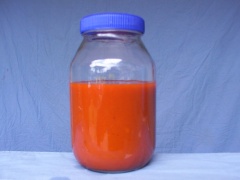Palm Oil
| Infobox on Palm Oil | |
|---|---|
| Example of Palm Oil |  |
| Facts | |
| Origin | This table shows only a selection of the most important countries of origin and should not be thought of as exhaustive.
|
| Density (in t/m3) |
|
| Temperature (in oC) | See text. |
| Humidity / moisture | Fats and fatty oils are insoluble in water. However, contact with water may give rise to soluble lower fatty acids and glycerol, which cause rancidity together with changes in color (yellow to brown), odor and taste as well as gelling and thickening. For this reason, the tanks must be absolutely dry after cleaning. |
| Ventilation | Ventilation must not be carried out under any circumstances, as it would supply fresh oxygen to the cargo, which would promote oxidation processes and premature rancidity. In this connection, care should be taken to ensure that the tank is filled as full as possible, taking into consideration possible thermal dilatation, and immediately closed. Palm oil bleaches on contact with air. |
| Self-heating / spontaneous combustion | - |
| Risk factors | see text. |
Palm Oil
Description
Palm oil is a red-yellow, fatty edible vegetable oil obtained from the fruit of the Oil palm tree. The oil palm is a tropical palm tree originally from West Africa. Palm kernel oil made from the seeds is used as cooking oil, to make margarine and is a component of some processed foods. Palm oil is high in olefins, a potentially valuable chemical group that can be processed into many non-food products as well. Palm oil has the largest slice of the world vegetable oil market - 28%, followed by soybean oil. 50% of world palm-oil production comes from Malaysia.
Application
Palm oil is processed to produce edible fats (margarine), soaps and candles and is used in pharmacy and cosmetics and as an important raw material in oleochemistry (fat chemistry).
Storage / transport
Storage duration of palm oil: approx. 6 months at 30°C
Loading temperature: 40°C
Favorable carrying temperature: 30-35°C, not <25°C
Pumping temperature: 49-50°C, not >55°C
Solidification temperature: approx. 35°C
Palm oil has a relatively high solidification point/range of 41° - 31°C.:
The rate of heating should be no greater than 8°C/day.
The acid value of an oil may be used as a measure of quality. Palm kernel oil should have an acid value of at most 0,1 - 1,0%. The acid value of the oil must not be too high, as this indicates an excessively high content of free Fatty Acids, which causes the oil to discolour and turn sour.
Oils and fats spoil by readily becoming rancid which is promoted by light, atmospheric oxygen and moisture and leads to changes in odor and taste.
To be able to pump the oil out of the tanks, it must be at the required pumping temperature. This is only possible, however, if the oil has been kept liquid during the voyage (above a minimum temperature). Loading, travel and pumping temperatures must be precisely complied with, since any change in consistency which occurs during transport may prove irreversible. If the oil solidifies in the tanks, it cannot be liquefied again even by forced heating. In the vicinity of the heating coils, the oil melts, scorches, discolors and becomes rancid.
Pumping out may be difficult in cold weather. The oil may cool too rapidly in the long lines and solid deposits form on the outer walls, which cannot be pumped out and prevent the still liquid cargo from reaching the suction valve. This problem can be solved by appropriate heating or insulation of the lines.
Separation and the associated change in consistency from liquid to solid occurs more readily upon cooling, the higher is the solidification point. Palm kernel oil has a relatively high solidification point/range of 24 - 19°C. In its native countries it has a liquid consistency, but in temperate latitudes it is fatty and has to be heated. Palm kernel oil is therefore also known as palm kernel fat. The oils must only be heated by a few °C per day, otherwise the risk of rancidity and other negative changes arises.
Palm Oil will loose its red colour when exposed to light, but this loss of colour does not affect the value for ordinary purposes. Excessive heat will cause bleaching and affect the colour.
For further details on deterioration, contamination, oxidation, transit and handling etc., we may refer to Bulk Oils and Fats and Fats and Oils.
Risk factors
- Self-heating / Spontaneous combustion
- Odor
- Contamination
- Mechanical influences
- Toxicity / Hazards to health
- Shrinkage / Shortage











